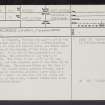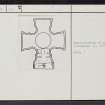Tyninghame, St Baldred's Church, Cross Fragment
Cross (Period Unassigned)
Site Name Tyninghame, St Baldred's Church, Cross Fragment
Classification Cross (Period Unassigned)
Alternative Name(s) Tyninghame House Policies
Canmore ID 57714
Site Number NT67NW 13.01
NGR NT 6197 7970
Datum OSGB36 - NGR
Permalink http://canmore.org.uk/site/57714
- Council East Lothian
- Parish Whitekirk And Tyninghame
- Former Region Lothian
- Former District East Lothian
- Former County East Lothian
Tyninghame 1 (St Baldred), East Lothian, cross-head fragment
Measurements: H 0.26m, W 0.26m, D 0.18m
Stone type: pink sandstone
Place of discovery: NT 6197 7970
Present location: uncertain.
Evidence for discovery: found around 1930 in the core of the tower of St Baldred’s Church, Tyninghame, and placed in the chapel of Tyninghame House. At some later date prior to 1992, it was moved to the former stables building, perhaps when the house was sold in 1986, and is now in the converted Stables House.
Present condition: broken and worn.
Description
This fragment forms part of the lower arm and upper shaft of a cross-head with cusped arms, carved in relief, with plain roll mouldings. Face A shows within the lower arm a broad frontal bust of a robed figure with bushy hair and arms held horizontally across the chest. Beneath the bust is the top portion of a panel containing two confronted horses with elongated tongues twisted together. The cusps on face B are plain, but the top of the shaft shows two confronted birds with a foliage spray between their beaks. The spray has three pointed leaves with scooped centres and two single berries, and behind the back of the right-hand bird are two plain pointed leaves. The necks of the birds have an inner incised line. Face C bears a panel of two-cord interlace which spans both the lower arm and the top of the shaft. The cusps on face D are plain, but the top of the shaft has a panel containing a foliate trail with a single-ridge node and two trilobed berry bunches. The lower bunch is grasped by the jaws of an upright animal whose left foreleg is braced against the stem, while its right foreleg is tucked back under its body. The body has an inner incised line, and the snout has fleshy lips curling back either side of the berries.
Date: late ninth century.
References: Stevenson 1959, 46-7.
Desk-based information compiled by A Ritchie 2016 & 2019.
Reference (1961)
(NT 6197 7970) A fragment, forming the upper part of the shaft and the lower part of the head of a free-standing cross, probably of late 9th century date, was found about 1930 in the core of the masonry of the tower of St Baldred's Church. It is now in the possession of the Earl of Haddington, and preserved in the chapel of Tyninghame House. The width of the shaft is 10 1/2 ins, thickness 7 ins, and the original span of the arms may be estimated at 22 1/2 ins. The ornamentation on the face is interpreted as two animal heads, perhaps horses, their tongues starting an interlace pattern; above this is a human figure on a seat. On one side are two birds and vine-scroll, and on the other, a small animal with vine-scroll.
R B K Stevenson 1961
External Reference (10 June 1992)
The cross fragment is still in the possession of the Earl of Haddington, and is now housed (at NT 6212 7997) in the former stables of Tyninghame House (NT67NW 3.4).
Information from Mr R Weatherhead, 10 June 1992.










